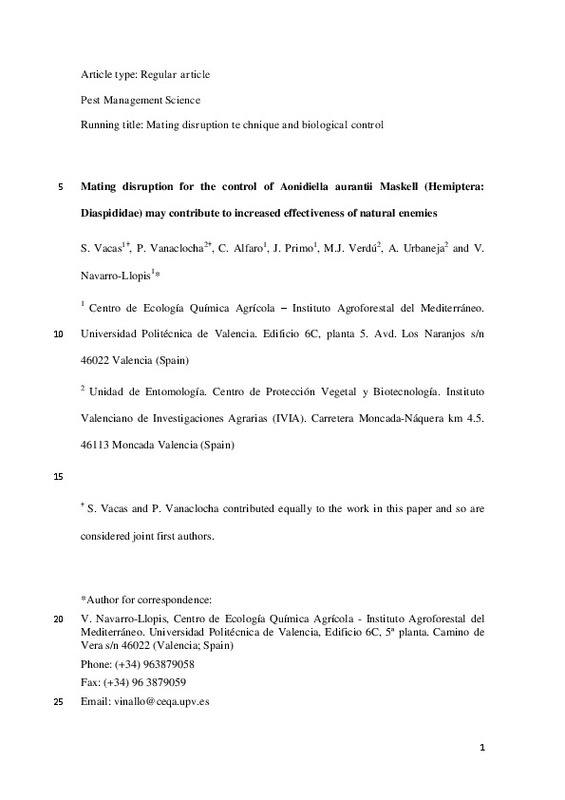JavaScript is disabled for your browser. Some features of this site may not work without it.
Buscar en RiuNet
Listar
Mi cuenta
Estadísticas
Ayuda RiuNet
Admin. UPV
Mating disruption for the control of Aonidiella aurantii Maskell (Hemiptera: Diaspididae) may contribute to increased effectiveness of natural enemies
Mostrar el registro sencillo del ítem
Ficheros en el ítem
| dc.contributor.author | Vacas González, Sandra
|
es_ES |
| dc.contributor.author | Vanaclocha, Pilar
|
es_ES |
| dc.contributor.author | Alfaro Cañamás, Cristina
|
es_ES |
| dc.contributor.author | Primo Millo, Jaime
|
es_ES |
| dc.contributor.author | Verdú, M.
|
es_ES |
| dc.contributor.author | Urbaneja García, Alberto
|
es_ES |
| dc.contributor.author | Navarro-Llopis, Vicente
|
es_ES |
| dc.date.accessioned | 2017-05-02T08:35:42Z | |
| dc.date.available | 2017-05-02T08:35:42Z | |
| dc.date.issued | 2012-01 | |
| dc.identifier.issn | 1526-498X | |
| dc.identifier.uri | http://hdl.handle.net/10251/80295 | |
| dc.description.abstract | Background: New directives on sustainable use of pesticides have encouraged research on efficient alternative pest control methods. In the case of the California red scale (CRS), Aonidiella aurantii (Maskell), this imperative, along with the many difficulties in controlling this pest, have led to the investigation of new approaches. Previously developed mating disruption (MD) dispensers, together with the augmentative releases of the parasitoid Aphytis melinus DeBach, are here considered as a combined strategy for use against A. aurantii. Results: Efficacy of MD was demonstrated by a mean reduction of 80% in CRS male catches and a mean fruit damage reduction of 83% compared with the control. A delay in the development of A. aurantii instars was observed in the MD plot. This delay increased the period of exposure of the susceptible instars to natural enemies, which resulted in higher predation and parasitism levels in the MD plot. Under laboratory conditions, A. melinus mating behaviour and effects on A. aurantii were not significantly altered in a CRS-pheromone-saturated environment. Conclusion: Mating disruption pheromone did not affect the behaviour or level of parasitism by A. melinus or the incidence of other generalist predators. Therefore, A. aurantii pheromone appears to be compatible with augmentative releases and biological control, making its use a good strategy for CRS management. © 2011 Society of Chemical Industry. | es_ES |
| dc.description.sponsorship | The authors thank H Monton (IVIA) and Aureli Marco (German Sancho y CIA SL) for technical assistance with experiments. This work was partially funded by the Spanish Ministry of Science and Innovation (projects AGL2008-05287-C04/AGR and AGL2009-10725) and the Conselleria d'Agricultura, Pesca i Alimentacio de la Generalitat Valenciana. PV was the recipient of a grant from IVIA. The authors also thank Ecologia y Proteccion Agricola SL for supplying the pheromone. | en_EN |
| dc.language | Inglés | es_ES |
| dc.publisher | Wiley | es_ES |
| dc.relation.ispartof | Pest Management Science | es_ES |
| dc.rights | Reserva de todos los derechos | es_ES |
| dc.subject | Aphytis melinus | es_ES |
| dc.subject | Biological control | es_ES |
| dc.subject | California red scale | es_ES |
| dc.subject | Mesoporous dispensers | es_ES |
| dc.subject | Parasitism | es_ES |
| dc.subject | Pheromone | es_ES |
| dc.subject | Biocontrol agent | es_ES |
| dc.subject | Generalist | es_ES |
| dc.subject | Insect | es_ES |
| dc.subject | Laboratory method | es_ES |
| dc.subject | Mating behavior | es_ES |
| dc.subject | Mating disruption | es_ES |
| dc.subject | Natural enemy | es_ES |
| dc.subject | Sustainable development | es_ES |
| dc.subject | Animal | es_ES |
| dc.subject | Article | es_ES |
| dc.subject | Evaluation | es_ES |
| dc.subject | Hemiptera | es_ES |
| dc.subject | Male | es_ES |
| dc.subject | Metabolism | es_ES |
| dc.subject | Methodology | es_ES |
| dc.subject | Pest control | es_ES |
| dc.subject | Physiology | es_ES |
| dc.subject | Reproduction | es_ES |
| dc.subject | Animals | es_ES |
| dc.subject | Pheromones | es_ES |
| dc.subject | Aonidiella aurantii | es_ES |
| dc.subject | Diaspididae | es_ES |
| dc.subject.classification | QUIMICA ORGANICA | es_ES |
| dc.title | Mating disruption for the control of Aonidiella aurantii Maskell (Hemiptera: Diaspididae) may contribute to increased effectiveness of natural enemies | es_ES |
| dc.type | Artículo | es_ES |
| dc.identifier.doi | 10.1002/ps.2239 | |
| dc.relation.projectID | info:eu-repo/grantAgreement/MICINN//AGL2009-10725/ES/Desarrollo Y Evaluacion De La Confusion Sexual Y El Control Microbiologico Como Metodos De Lucha Contra El Piojo Rojo De California Aonidiella Aurantii Maskell/ | es_ES |
| dc.relation.projectID | info:eu-repo/grantAgreement/MICINN//AGL2008-05287-C04-01/ES/SISTEMAS DE PRODUCCION INTEGRADA EN CITRICOS: MANIPULACION DEL AGROSISTEMA PARA LA MEJORA DEL CONTROL DE PLAGAS/ | es_ES |
| dc.rights.accessRights | Abierto | es_ES |
| dc.contributor.affiliation | Universitat Politècnica de València. Instituto Agroforestal Mediterráneo - Institut Agroforestal Mediterrani | es_ES |
| dc.contributor.affiliation | Universitat Politècnica de València. Escuela Técnica Superior de Ingenieros Industriales - Escola Tècnica Superior d'Enginyers Industrials | es_ES |
| dc.description.bibliographicCitation | Vacas González, S.; Vanaclocha, P.; Alfaro Cañamás, C.; Primo Millo, J.; Verdú, M.; Urbaneja Garcia, A.; Navarro-Llopis, V. (2012). Mating disruption for the control of Aonidiella aurantii Maskell (Hemiptera: Diaspididae) may contribute to increased effectiveness of natural enemies. Pest Management Science. 68(1):142-148. doi:10.1002/ps.2239 | es_ES |
| dc.description.accrualMethod | S | es_ES |
| dc.relation.publisherversion | http://dx.doi. org/10.1002/ps.2239 | es_ES |
| dc.description.upvformatpinicio | 142 | es_ES |
| dc.description.upvformatpfin | 148 | es_ES |
| dc.type.version | info:eu-repo/semantics/publishedVersion | es_ES |
| dc.description.volume | 68 | es_ES |
| dc.description.issue | 1 | es_ES |
| dc.relation.senia | 207909 | es_ES |
| dc.contributor.funder | Ministerio de Ciencia e Innovación | es_ES |
| dc.contributor.funder | Institut Valencià d'Investigacions Agràries | es_ES |
| dc.contributor.funder | Generalitat Valenciana | es_ES |






![[Cerrado]](/themes/UPV/images/candado.png)


